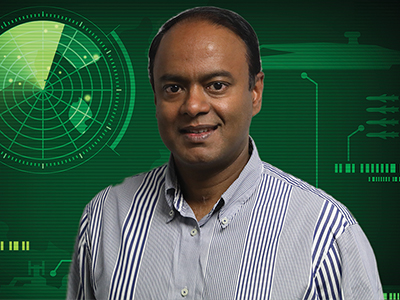Improving target tracking

Defence scientist Dr Sanjeev Arulampalam is revolutionising algorithms for tracking targets of interest to Defence.
He's doing this in two ways: by fusing 'soft' human generated data sources with 'hard' sensor data, and by beefing up the ability of the algorithms to handle ambiguity and uncertainty in model parameters.
Automating target motion analysis
With his experience in submarine combat systems, Arulampalam is attempting to improve existing tracking algorithms by adding in 'fuzzy' human data.
"The tracking algorithms currently only operate on 'hard' data from physics-based sensors like hydrophones," Arulampalam explains.
'Soft' data, on the other hand, is human interpreted observations such as Navy officers' periscope observations, known geographical constraints and intelligence reports.
"Currently there are no algorithms on-board our submarines that fuse 'soft' data," says Arulampalam.
"The periscope operator might comment on where they believe the target is and that kind of information is currently incorporated manually by the target motion analysis operator."
Target motion analysis is one of the key functions of submarine combat systems, and it still requires a significant amount of operator interaction. With the anticipated increase in the amount of information available in the future, particularly with the deployment of autonomous systems, this process is expected to put a heavy burden on the operators.
Arulampalam aims to remove the need for operator intervention in the low level fusion for tactical picture compilation so that they can focus more of their efforts on high level decision making to which he says humans are better suited.
"There's been a lot of work done on data fusion, but it's really only now that researchers are starting to focus on the fusion of soft data from human operators and other "fuzzy" sources," says Arulampalam.
"These are important considerations for both the future submarine development under the Future Submarine program and for theatre level anti-submarine warfare operations."
Algorithms that can deal with change
Arulampalam says current automatic tracking algorithms tend to fail when assumptions don't match reality.
"I want to create robust algorithms that can work with uncertain model parameters and handle a possible mismatch in these parameters and reality," Arulampalam says.
"I hope to create algorithms that can learn these model parameters on the fly as the target is being tracked."
If Arulampalam is successful, this will be a revolutionary approach to the conduct of target motion analysis for undersea situational awareness - an approach that promises improved situational awareness with reduced operator workload for low-level fusion.
Arulampalam is collaborating with world-class experts in the area of statistical information fusion using Bayesian methods from RMIT, UTS and McMaster University in Canada. Collaborations with the University of South Australia and Curtin University are also planned.

